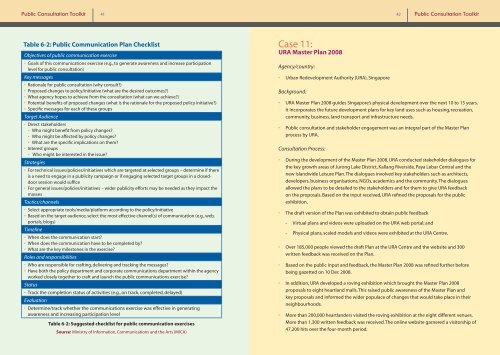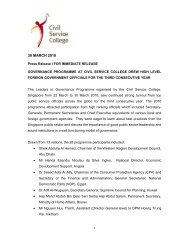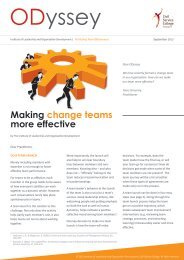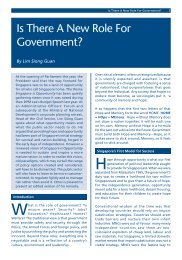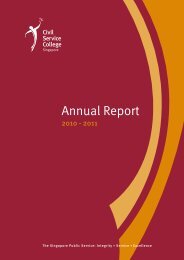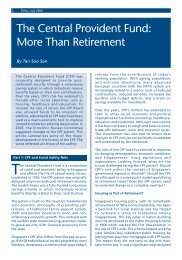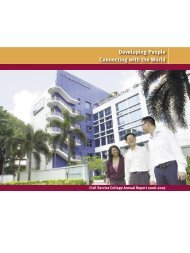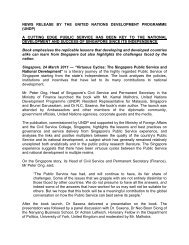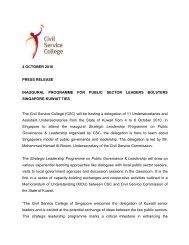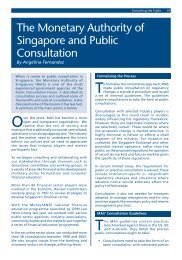Public Consultation Toolkit - Civil Service College
Public Consultation Toolkit - Civil Service College
Public Consultation Toolkit - Civil Service College
You also want an ePaper? Increase the reach of your titles
YUMPU automatically turns print PDFs into web optimized ePapers that Google loves.
<strong>Public</strong> <strong>Consultation</strong> <strong>Toolkit</strong> 41 42 <strong>Public</strong> <strong>Consultation</strong> <strong>Toolkit</strong><br />
Table 6-2: <strong>Public</strong> Communication Plan Checklist<br />
Objectives of public communication exercise<br />
• Goals of this communications exercise (e.g., to generate awareness and increase participation<br />
level for public consultation)<br />
Key messages<br />
• Rationale for public consultation (why consult?)<br />
• Proposed changes to policy/initiative (what are the desired outcomes?)<br />
• What agency hopes to achieve from the consultation (what can we achieve?)<br />
• Potential benefits of proposed changes (what is the rationale for the proposed policy initiative?)<br />
• Specific messages for each of these groups<br />
Target Audience<br />
• Direct stakeholders<br />
- Who might benefit from policy changes?<br />
- Who might be affected by policy changes?<br />
- What are the specific implications on them?<br />
• Interest groups<br />
- Who might be interested in the issue?<br />
Strategies<br />
• For technical issues/policies/initiatives which are targeted at selected groups – determine if there<br />
is a need to engage in a publicity campaign or if engaging selected target groups in a closeddoor<br />
session would suffice<br />
• For general issues/policies/initiatives – wider publicity efforts may be needed as they impact the<br />
masses<br />
Tactics/channels<br />
• Select appropriate tools/media/platform according to the policy/initiative<br />
• Based on the target audience, select the most effective channel(s) of communication (e.g., web,<br />
portals, blogs)<br />
Timeline<br />
• When does the communication start?<br />
• When does the communication have to be completed by?<br />
• What are the key milestones in the exercise?<br />
Roles and responsibilities<br />
• Who are responsible for crafting, delivering and tracking the messages?<br />
• Have both the policy department and corporate communications department within the agency<br />
worked closely together to craft and launch the public communications exercise?<br />
Status<br />
• Track the completion status of activities (e.g., on track, completed, delayed)<br />
Evaluation<br />
• Determine/track whether the communications exercise was effective in generating<br />
awareness and increasing participation level<br />
Table 6-2: Suggested checklist for public communication exercises<br />
Source: Ministry of Information, Communications and the Arts (MICA)<br />
Case 11:<br />
URA Master Plan 2008<br />
Agency/country:<br />
• Urban Redevelopment Authority (URA), Singapore<br />
Background:<br />
• URA Master Plan 2008 guides Singapore’s physical development over the next 10 to 15 years.<br />
It incorporates the future development plans for key land uses such as housing, recreation,<br />
community, business, land transport and infrastructure needs.<br />
• <strong>Public</strong> consultation and stakeholder engagement was an integral part of the Master Plan<br />
process by URA.<br />
<strong>Consultation</strong> Process:<br />
• During the development of the Master Plan 2008, URA conducted stakeholder dialogues for<br />
the key growth areas of Jurong Lake District, Kallang Riverside, Paya Lebar Central and the<br />
new Islandwide Leisure Plan. The dialogues involved key stakeholders such as architects,<br />
developers, business organisations, NGOs, academics and the community. The dialogues<br />
allowed the plans to be detailed to the stakeholders and for them to give URA feedback<br />
on the proposals. Based on the input received, URA refined the proposals for the public<br />
exhibition.<br />
• The draft version of the Plan was exhibited to obtain public feedback<br />
- Virtual plans and videos were uploaded on the URA web portal; and<br />
- Physical plans, scaled models and videos were exhibited at the URA Centre.<br />
• Over 185,000 people viewed the draft Plan at the URA Centre and the website and 300<br />
written feedback was received on the Plan.<br />
• Based on the public input and feedback, the Master Plan 2008 was refined further before<br />
being gazetted on 10 Dec 2008.<br />
• In addition, URA developed a roving exhibition which brought the Master Plan 2008<br />
proposals to eight heartland malls. This raised public awareness of the Master Plan and<br />
key proposals and informed the wider populace of changes that would take place in their<br />
neighbourhoods.<br />
• More than 200,000 heartlanders visited the roving exhibition at the eight different venues.<br />
More than 1,300 written feedback was received. The online website garnered a visitorship of<br />
47,200 hits over the four-month period.


